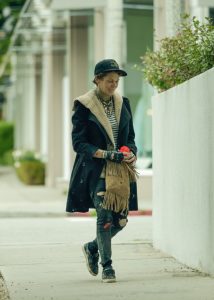Loni Willison, a former fitness model and the ex-wife of Jeremy Jackson from Baywatch, was recently spotted walking around Los Angeles. This story is just another tragic chapter in a lengthy, horrible public slide. People used to know the 40-year-old for her bright appearances on magazine covers and at red carpet events. She has been homeless for almost ten years after years of battling addiction, mental illness, and personal trauma.
On June 29, people in Los Angeles saw Willison hauling a shopping cart full of blankets and other personal items down the street. She wore a skirt over leggings, a loose-fitting top, white stockings, and a baseball cap turned backwards. There were a lot of bangles on her arms and a bunch of necklaces that were all twisted up around her neck. Her expression was blank and contemplative, and she looked rough. People noticed her looking out at the world and smoking a cigarette. She was a lady alone in a city that used to honor her beauty and success.

A lot of people have written about Willison’s fall, but not many have showed understanding. Her story isn’t one of scandal; it’s one of repeated failure, unresolved trauma, and mental health issues that haven’t been dealt with. In the early 2000s, she was a well-known figure in the fitness world, appearing on the pages of magazines including Iron Man, Flavour, and Glam Fit. She had a great body and a strong personality, which made it appear like she was going to be successful for a long time. She was in the news for a short time when she married Jeremy Jackson in 2012. He was famous for playing Hobie Buchannon on the hit TV show Baywatch. But rumors say that their relationship was tumultuous and not very nice when they were alone.
After they broke up in 2014, Willison’s life fell apart quickly. The couple was married for less than two years. She lost her job as an assistant at a cosmetic surgery center, and not long after that, she lost her apartment. In interviews over the past few years, she has indicated that her fall into homelessness wasn’t just about losing her things; it was also about losing her hold on reality. In 2016, she said she had a mental breakdown because she feared someone were trying to hurt her by sending electrical currents through her body. She isolated herself off from friends and family and refused to obtain help because of these obsessive ideas. She started using meth because she felt it would help her forget about the feelings she thought she was feeling.
After that, she moved out onto the streets.

People have seen her since then, often in bad situations like going through garbage cans, with dirty or painted hands, in ripped clothes, or wheeling her grocery cart from one neighborhood to another. People saw her lately looking through a dumpster for personal care items like mouthwash and makeup. This is a scary contrast from her previous life as a fitness celebrity and public figure. In another instance, she was seen at a 99 Cents store that is now closed, trying to make the most of what little she had.
Over the years, Willison’s public comments have given us brief looks into her mental state. In a 2020 interview with X17 Online, she revealed that a lot of her troubles were caused by her first marriage. “My ex-husband.” Getting married. She said fiercely, “At least I got a divorce; it made things easier.” She didn’t really trust the people who were attempting to help her either, and she insisted she was OK on her own. “I haven’t talked to Jeremy yet. I’d rather not chat to my friends. I’m doing very well. I don’t want anyone to help me. I can take care of myself. I have everything I need right here.
People like photographers, journalists, and even outreach groups have tried many times to talk to her or help her, but she has always said no. Her situation shows one of the most upsetting things about chronic homelessness: many people with untreated mental illness often slip between the cracks and don’t get long-term, trauma-informed help.

People who know her have expressed that they are sad. Cindy Kovacs, another of Jeremy Jackson’s ex-girlfriends, spoke out in an interview and stated, “It’s sad what happened to Loni, and she never got the help she needed.” What she stated indicates how powerless and dissatisfied people feel when they see Willison drift away into the background of society.
Willison’s story isn’t only a warning from Hollywood; it’s a sad story about humans. At one point, everyone adored, took pictures of, appreciated, and remembered this individual. Now, they are merely rumors and blurry pictures on the streets of Los Angeles. But there is still a person under all the dirt, broken stuff, and the way they look. This person needs help, protection, and a chance to get better.

Her tale reveals that even in one of the richest cities in the US, people can be mentally ill, traumatized, and homeless at the same time. There are thousands of more folks like Loni Willison whose stories we don’t hear. Willison’s story is a clear reminder that being beautiful, popular, and wealthy doesn’t protect you from the hardest things in life. Society is still trying to figure out how to deal with these intricate challenges.
We can only hope that one day she will accept the help she needs and that the right people will be there to provide it to her with kindness, not judgment.
